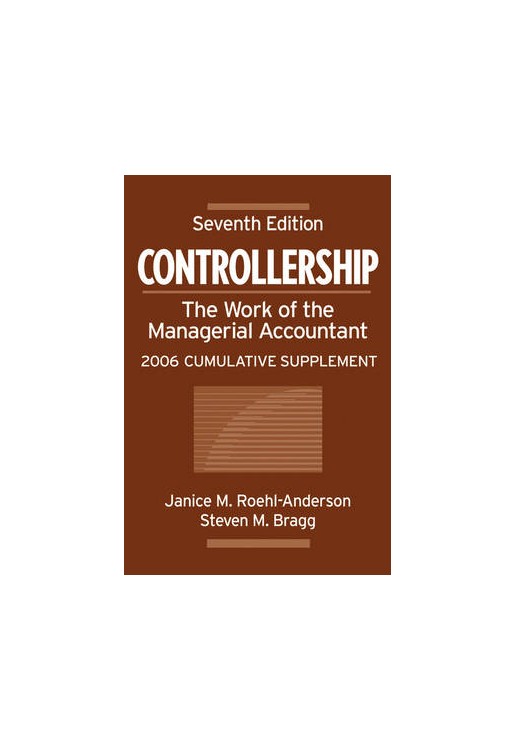


Preface.
PART 1 THE BROAD MANAGEMENT ASPECTS OF CONTROLLERSHIP.
1 Accounting in the Corporation.
* 1.5 Impact of Ethics on the Accounting Role.
8 Internal Audit Function.
* 8.3A Audit Committee Charter (New).
* 8.4 Role of the Audit Committee.
PART 2 THE PLANNING FUNCTION OF CONTROLLERSHIP.
14 Profit Planning: Annual Plan.
* 14.5A Problems with the Annual Plan (New).
PART 3 PLANNING AND CONTROLLING OPERATIONS.
19 Planning and Control of Marketing Expenses.
* 19.3 Overview of Marketing Activities (Revised).
25 Payroll.
* 25.12 Improving the Payroll Process (New).
PART 4 PLANNING AND CONTROL OF THE BALANCE SHEET.
26 Planning and Control of Cash and Short-Term Investments.
* 26.10A Variations in Cash Requirements by Industry (New).
27 Planning and Control of Receivables.
27.1 Introduction (Revised).
27.2 Credit Policies, Procedures, and Systems (New).
27.2A Collection Policies, Procedures, and Systems (New).
28 Planning and Control of Inventories.
28.1 Introduction (Revised).
28.2A Inventory Purchasing (New).
28.2B Inventory Receiving and Shipping (New).
28.2C Inventory Storage (New).
28.2D Inventory Picking (New).
28.2E Production Issues Impacting Inventory (New).
28.2F Inventory Transaction (New).
28.2G Inventory Quantity Management (New).
28.2H Warehouse Layout (New).
PART 5 FINANCIAL AND RELATED REPORTS.
36 Securities and Exchange Commission.
* 36.7A Implications of the Sarbanes-Oxley Act (New).
PART 6 COMPUTER SYSTEMS AND RELATED TECHNOLOGY.
* 39A Leading Practices in Testing Highly Configurable Software Packages (New).
39A.1 Introduction: Why Test Off-the-Shelf Software Packages?
39A.2 Software Testing: How Much Is Enough?
39A.3 Testing Methodologies: What Should Be Tested, and How?
39A.4 Testing Leading Practices.
39A.5 Conclusion.
41A Maintaining and Upgrading ERP Financial Systems (New).
41A.1 Overview.
41A.2 Current State.
41A.3 Key Strategies to Minimize Cost.
41A.4 Conclusion.
41B Impact of Enterprise Applications on Finance (New).
41B.1 How do These Deployments Affect Me?
41B.2 Pitfalls.
41B.3 What Leads to an Increased Risk Profile?
41B.4 What Can You Do?
41B.5 Conclusion.
* 51A Leveraging Business Process Management Technologies for Sarbanes-Oxley Section 404 Compliance (New).
51A.1 Introduction.
51A.2 Essential Features of a Comprehensive BPM Solution.
51A.3 Path to Compliance.
51A.4 Leveraging Investments in BPM Beyond Sarbanes-Oxley.
51A.5 Conclusion.
PART 7 SOME ADMINISTRATIVE AND SPECIAL ASPECTS OF THE CONTROLLER’S DEPARTMENT.
52 Financial Planning and Analysis for Acquisitions, Mergers, and Divestments.
* 52.8 Evaluating the Prospect: In-Depth Analysis.
* 52.11 Valuation of an Acquisition.
* 52.19 Mistakes by Management.
* 52A The Missing Piece of the Merger and Acquisition Puzzle (New).
52A.1 Introduction.
52A.2 What Can Be Done to Address These Issues?
52A.3 Conclusion.
* 52B Walking the Merger and Acquisition Tightrope—with a Safety Net (New).
52B.1 Introduction.
52B.2 What Is M&A Capability Development and How Can It Help?
52B.3 Conclusion.
56 Reporting Period and How to Close It.
* 56.6 How to Achieve a Fast Close (Revised).
* 56.6A Summary (New).
59 Records Management.
* 59.2A Need for Tighter Control Over Records Management (New).
62 Risk Management.
* 62.4 Trends in Insurance Coverage.
* 62.6A Evaluating the Health of an Insurance Carrier (New).
* 62.8A Risk Management Planning (New).
Index.